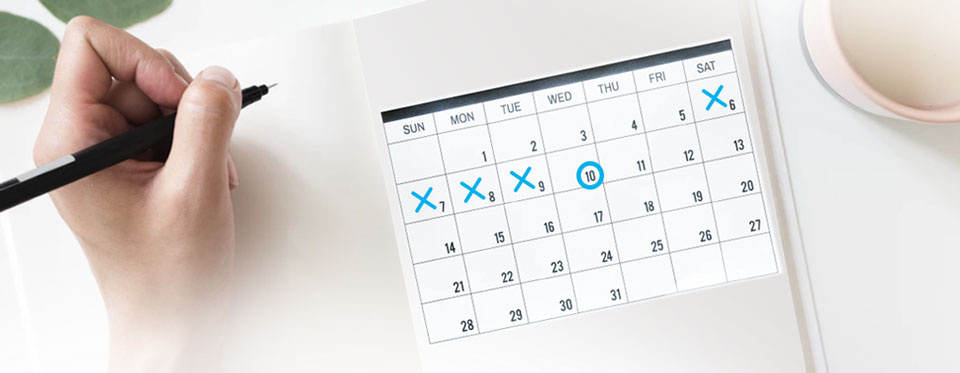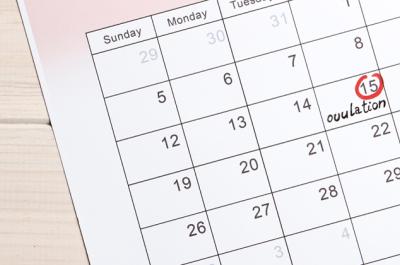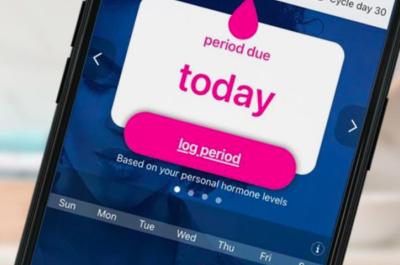How to track your menstrual cycle and ovulation

Knowledge is power, and understanding your menstrual cycle and ovulation is one of the easiest ways to take ownership of and manage your fertility. Tracking your menstrual cycle and knowing the day you ovulate is an important tool for all women.
Knowing when you ovulate is especially helpful when trying to get pregnant. According to a January 2020 study in Journal of Women’s Health, women who used Clearblue®’s Connected Ovulation Test System were twice as likely to become pregnant in their first cycle of use compared to women not using an ovulation test.1
Every woman is different. Menstrual cycles and ovulation days vary from woman to woman, and even in the same woman from cycle to cycle. We’re here to remove the guesswork.
First, a quick health lesson
Day 1 of your cycle is the first day of your period (the first day of bleeding). Your body begins breaking down the lining of your uterus, and bleeding typically lasts three to seven days. During this stage of your cycle, your pituitary gland produces FSH (follicle-stimulating hormone), and fluid-filled follicles develop on your ovaries. Each follicle contains one egg.
The next phase of your cycle is called the follicular phase. This is the phase that leads up to ovulation. Typically, only one follicle keeps growing and starts to release increased levels of estrogen. Your uterine lining also becomes thick with nutrients and blood.
In a typical cycle, ovulation occurs next. High estrogen levels trigger an LH (luteinizing hormone) surge, forcing your follicle to rupture and release its egg, sending it through your Fallopian tube. Your egg will live 12 to 24 hours.
The time period after you ovulate is called the luteal phase. Your follicle begins making more progesterone, a hormone that helps the lining of the uterus store more blood and nutrients. The egg travels down the fallopian tube to the uterus. If the egg has been fertilized, it may embed in the uterine lining, marking the beginning of a pregnancy.
If the egg is not fertilized, the level of progesterone declines, the uterine lining breaks down and the egg is shed, along with your uterine lining, during your period.
When is your fertility window, and how long does it last?
Sperm can live for up to five days in your body after sex. Certain cervical mucus changes during this time create an environment more friendly to sperm. So although an egg only lives for up to 24 hours, your fertility window includes both the lifetime of the sperm and the egg — about six days. Peak fertility occurs the day before and the day of ovulation.
Tracking your cycle with physical ovulation symptoms
Leading up to ovulation, cervical mucus becomes clear and slippery, with a consistency akin to egg whites. During ovulation, some women feel a twinge of one-sided pain, sometimes called mittelschmerz, described as sharp or cramping. After ovulation, basal body temperature (which means resting body temperature — the moment you wake up and before you get out of bed) slightly rises.
quick search online can lead to many free fertility charts you can download and print to help you track your physical symptoms. By taking your basal temperature daily, tracking your menstrual cycle and making notes of how your body physically feels each day, you can, with time, see patterns that can help you better identify the day you’re likely to ovulate. If a paper graph or chart feels too old-school, many apps now exist allowing you to easily track these physical signs on your computer or phone, including the new Clearblue® Me app.
However, relying on physical changes alone to manage fertility comes with a few challenges; many women don’t experience ovulation symptoms, or their symptoms vary from cycle to cycle. And a change in your cervical mucus is the only truly predictive physical symptom.
Predicting ovulation with the LH surge
The LH surge we talked about earlier is the key to predicting ovulation. Ovulation tests can be more than 99% accurate in detecting an LH surge. Since ovulation typically occurs 24 to 36 hours after an LH surge, using ovulation tests makes it much easier to know when to have sex to maximize your chances of getting pregnant.
How do ovulation tests work?
Three Clearblue® tests (Fertility Monitor with Touch Screen, Connected Ovulation Test System and Advanced Digital Ovulation Test) monitor both your estrogen and LH levels, identifying more days when you are fertile, compared with most other ovulation tests. Remember that your estrogen level rises first, followed by a surge in LH level. The Clearblue® Digital Ovulation Test detects your LH surge, identifying your two days of peak fertility.
It’s important to know the day your last period started before using an ovulation test. From there, the type of test you choose will determine the right day to start testing. This calculator can help.
When testing, it’s important to use your first urine of the day. Just like with a pregnancy stick test, you’ll either pee on the test’s absorbent tip, or dip the tip in urine collected in a clean, dry container. Your test instructions will tell you how long to hold the test in the urine sample and how long to wait for the results, as well as how to read the results. You will test daily to determine your peak fertility days. Once you’ve detected your LH surge, you can stop testing for that cycle and keep any remaining tests in case you need them for the following cycle.
Not sure which test to choose? Check out our comparison chart here.
For years, you’ve probably tied conception to menstruation. Your period (or lack of) can tell you if you’re pregnant, but it’s your ovulation that determines when pregnancy is most likely to happen. The timing of ovulation is hard to pinpoint without the accuracy of an ovulation test or fertility monitor. This particular knowledge gives you the power to better control an important aspect of your day-to-day life.
Predicting ovulation: A not-so-old history2
For centuries, the timing of conception was mired in falsehoods, superstitions and misunderstandings. The study and understanding of ovulation is relatively new. Here’s a quick look:
- 1920s to 1930s
Gynecologists discover ovulation typically occurs around 12 to 16 days before the onset of the next period; tracking basal body temperature first promoted as a natural form of birth control
- 1932
“The Rhythm of Sterility and Fertility in Women” first published; rhythm method calculators popular
- 1950s
Changes in cervical mucus near time of ovulation discovered
- 1960s
The Billings Ovulation Method introduced
- 1970s
Sympto-thermal method, combining rhythm, basal body temperature and cervical mucus changes, popularized
- 1989
Clearblue® launches world’s first one-step home ovulation test, measuring LH
- 1999
Two-Day Method and CycleBeads, both based on the Standard Days Method, introduced; Clearblue® launches first at-home fertility monitor measuring estrogen and LH, identifies a wider fertility window
- 2004
Clearblue®’s first digital smiley face ovulation test released
- 2013
Clearblue® launches first Advanced Ovulation Test to detect two key fertility hormones
- 2017
Clearblue® launches Connected Ovulation Test System, tracking estrogen and LH while syncing to your phone

Looking for insights on your health journey? Clearblue® sends you curated, science-backed articles right to your inbox.
Sources
- Johnson, S., Stanford, J. B., Warren, G., Bond, S., Bench-Capon, S., & Zinaman, M. J. (2020). Increased Likelihood of Pregnancy Using an App-Connected Ovulation Test System: A Randomized Controlled Trial. Journal of Women’s Health, 29(1), 84-90. https://doi.org/10.1089/jwh.2019.7850.
- Rhythm Method. (n.d.). Dittrick Medical History Center. Retrieved March 4, 2021, from https://artsci.case.edu/dittrick/online-exhibits/history-of-birth-control/contraception-in-america-1900-1950/rhythm-method/.




